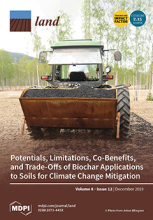/ library resources
Showing items 1 through 9 of 27.A discussion of the assumptions that underlie efforts to register land enables us to not only evaluate their validity across different contexts, but most importantly, to further understand how the low incidences of land registration might derive from very fundamental sources outside of difference
The aim of the paper was to present the procedure of building neighborhood resilience to climate threats, embedded in planning (from the strategic to local level) and design process and focused on usage of natural adaptive potential.
Street trees, native plantings, bioswales, and other forms of green infrastructure alleviate urban air and water pollution, diminish flooding vulnerability, support pollinators, and provide other benefits critical to human well-being.
Urban green spaces are frequently presented as being important for urban quality of life and urban development in general, but more detailed interpretations and discussions are typically confined to large urban centers, the so-called first- and second-tier cities.
Development practice over recent years in much of Africa prioritized formalization of land policies deemed to enhance better handling and use of land as an asset for social development.
The urban sprawl process of Ulaanbaatar has changed dramatically due to population growth. Ulaanbaatar city land management master plan defined the settlement zone area suitable for living as 33,698 ha.
Most election pledges require a significant budget for their implementation.
Documentation of land rights can ensure tenure security and facilitate smooth land transactions, but in most countries of the global south this has been difficult to achieve.
Urbanization rate in Central America is the second fastest worldwide and its major cities face challenges regarding urban sustainability. Urban Green Fabric (UGF) is an important material condition for the urban quality of life and, therefore, key to planning processes.
Pagination
Land Library Search
Through our robust search engine, you can search for any item of the over 73,000 highly curated resources in the Land Library.
If you would like to find an overview of what is possible, feel free to peruse the Search Guide.





